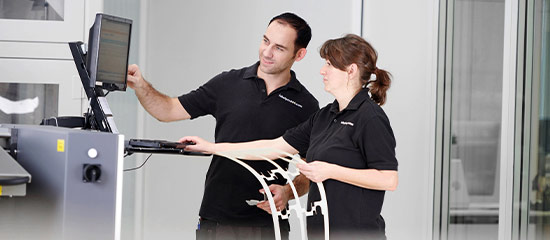
Basic knowledge of packaging: The most important terms around the topic of packaging
-
"Packaging" is usually quite sufficient for explanation in everyday language use, but the term conceals a complex subject.
-
What exactly constitutes packaging is regulated at the legal level by the Packaging Act.
-
ore precise specifications on the requirements and properties of packaging and its components are given in DIN standard 55405 – but its application is voluntary.
-
The technical language in the packaging industry is not so easy to understand for laypeople with its many similar-sounding terms – which is why we shed light on the basic terms in our "Basic Packaging Knowledge".
.jpeg)
What is packaging? Everyone knows that. And yet, in everyday life, even the simplest terms relating to packaging quickly become confused.
Then it may even be difficult to explain the difference between packaging and package correctly. To prevent this from happening, we have compiled the most important basic terms and their meaning.
Define "packaging"!
In everyday language, a more precise explanation of what is meant by "packaging" is usually not necessary. However, when it comes to a professional discussion of the term, it is worth taking a closer look at the common definitions and terminology.
Apart from that, it is advisable for consumers to master the basics. After all, there is quite a complex system for waste separation in Germany and the requirements for the different types of packaging and materials are becoming increasingly strict.
.jpeg)
What does the Packaging Act say?
The first place to go to find out about the definitions of packaging is the "Act on the marketing, return and high-quality recovery of packaging" – the Packaging Act (VerpackG). In §3 it introduces the legal definitions.
The first section states:
"Packaging is a product made of any material to contain, protect, handle, deliver or present goods, which may range from raw material to processed product, passed from the manufacturer to the distributor or final consumer [...]".
The Packaging Act then distinguishes between several areas of application of packaging:
-
Sales packaging is a sales unit consisting of goods and packaging, intended for the final consumer. However, it may also be packaging that is filled at the final operator. In this case, it is either service packaging (enabling or supporting the transfer of goods) or shipping packaging (enabling or supporting the shipment of goods).
-
Outer packaging contains a certain number of sales units. They are either offered together with these sales units or serve to fill the store shelves.
- Transport packaging helps to ensure that goods are not damaged during transport and handling. Such packaging does not usually reach the end consumers.
Sections 2 to 8 of the Act also list other types of packaging and criteria for their precise determination. Other types are therefore explained:
-
Beverage packaging
-
Reusable and disposable packaging
-
Single-use plastic packaging
-
Single-use plastic food packaging
-
Single-use plastic drinks bottles
-
Composite packaging
-
Packages emptied of residues
- Packaging subject to system participation
By the way, according to the text of the law, the latter are sales and secondary packaging that are disposed of in the waste after use by private end consumers.
Packaging or non-packaging?
A question that the Central Packaging Register (ZSVR) obviously has to deal with more often. Therefore, the ZSVR has developed a topic paper with 5 criteria with which packaging and non-packaging can be distinguished according to the Packaging Act:
-
Presence of a packaging function
-
Connection with a good
-
Not an integral part of the product
-
Product determination and value instead of "second use”
-
Packaging components and additional elements
The standardised concept of packaging
The Packaging Act provides the definitions for various types of packaging. It gets even more precise with DIN 55405 DIN 55405 – the standard for packaging, which also defines terminology and definitions.
Uniform terms for packaging
Clear specifications for the properties and requirements of packaging, simplified international trade in goods, better rationalisation and more safety for manufacturers, traders and consumers: there are many reasons why DIN 55405 is so detailed in its versions and explanations.
Packaging materials are also included in the scope of the standard, as are distinctions between different types of packaging. In addition, terms such as "packaging/sealing", "packaged goods/package/item", "handling and processing" and "dimensions and volumes" are dealt with.
DIN standards and the legal framework
Although the DIN standards are important, their application is voluntary. They only become binding if, for example, they are part of contracts or expressly prescribed by law. However, it always helps to be able to prove that a proper procedure has been carried out in accordance with the DIN standards.
Quite a lot of packaging
The DIN standard deals with the different types of packaging in the chapter "Classification of packaging terms". A total of 40 different types of packaging are listed here. The general packaging categories of the Packaging Act are also listed, otherwise, there is a clear differentiation.
The list ranges from more overarching categories such as "outer and inner packaging" to specific types such as "commercial packaging", "store-ready packaging", "display packaging", "keep-warm packaging" and numerous others.
One reason for the listed packaging diversity is the linguistic area: DIN points out that both technical language and linguistic usage were taken into account in order to define uniform terms for packaging.
Standardisation is international
At the national level, standardisation projects only account for a comparatively small share of around 15 per cent - the majority are designed for Europe-wide or international validity.
Nevertheless, DIN's work remains very important. As a member of the International Organization for Standardization (ISO) and the European Committee for Standardization, it helps to represent German interests in matters of standardisation.
Why not all packaging is the same – and what else you need to know:
"Tear open the package" necessarily means "tear open the packaging", yet the two terms each mean something different. To prevent misunderstandings, we explain the subtle differences between the most important terms in packaging.
Package & Packaging
If the muesli pack is passed on at the breakfast table, then this usually also applies to the muesli pack. Conversely, it is perfectly possible to pass on only the muesli packaging. The explanation for this is very simple:
-
DIN 55405 understands packaging as the unit of all packaging materials and packaging aidsthat are required for the classic packaging functions (protection, rationalisation, transport, labelling, information, etc.).
- The term "package" refers to the combination of the packaging and its contents .
By the way, the technical term for this is packaged goods (alternatively: filled goods) and this includes all products that require packaging for their protection. The simple calculation is, therefore: packaged goods plus packaging equals package.
DIN standard 55405 lists a total of 46 different types of packaging. They are differentiated according to their respective properties. For example, the composition (stretch or shrink pack), the place of use (hospital, industrial or commercial pack) or the size (portion pack, blister pack, etc.) can be used for this.
Because the diverse products place equally diverse demands on the respective packaging, we offer a wide range of packaging products. With folding boxes, shipping cartons, pouch packaging and tubes in numerous designs and individual customisation options, everything from liquid to heavy, solid products can be optimally and efficiently packaged in them.
Packaging material & Packaging container
Not entirely unproblematic for laypeople: the technical vocabulary of packaging consists largely of similar-sounding terms. A (further) example of this is packaging material and packaging container, which are, however, clearly different on closer inspection:
-
Packaging materials are in fact the materials and fibres, from which the packaging containers (and packaging aids) are created in the first place. Paper, cardboard, plastic, wood, aluminium and some other packaging materials are suitable for this purpose.
- The packaging components that partially or completely enclose the packaged goods are referred to as packaging containers.
As the name suggests, packaging aids simply supplement the packaging containers so that they can fulfil all the desired and required packaging functions. They help to close, label, cushion, open, handle or generally protect the contents of the packaging.
Packaging containers are defined very broadly in the DIN standard so large types of packaging materials such as pallets are also included.
.jpeg)
Packing & Sealing
The two terms tempt one to use them synonymously, especially in common parlance. After all, sealing is part of packaging. It's just that they are two completely different areas when it comes to technical implementation.
-
Packaging encompasses a wide range of activities, from erecting to gassing, wrapping and foiling to filling - to name just a few examples.
- Sealing is initially a part of these activities. A closer look reveals an enormous range of different sealing types. DIN 55405 mentions 62 ways to seal packaging. The adhesive tape closure, which is usually used to seal shipping boxes in the private sector, is just as much a part of this as ear closures, embossed closures or tear-off closures.
Ultimately, packaging and sealing, therefore, describe different work steps on the way to a finished, filled and securely sealed package.
These articles might also interest you:

Customised packaging
These are individually manufactured packages such as folding boxes, shipping cartons or laminate tubes. Thanks to the individual adaptation to the size, weight and nature of the packaged goods, space and money can be saved.

Digital print shop 4.0
The "Industry 4.0" strategy aims to merge the Internet and new IT technologies with production technologies such as robotics and automation in order to reduce costs, save time and enable new, innovative products and services.

Creating the correct die-cutting contour
To ensure smooth label printing, our pre-press team needs a die-cutting contour. Most of the time, this is already created directly by the customer, but it still happens from time to time that the die-cutting contour is missing.








 Roll labels request form
Roll labels request form  Booklet labels request form
Booklet labels request form  Folding boxes request form
Folding boxes request form  Custom made shipping boxes request form
Custom made shipping boxes request form  Package leaflets request form
Package leaflets request form  Laminate tubes request form
Laminate tubes request form 



















